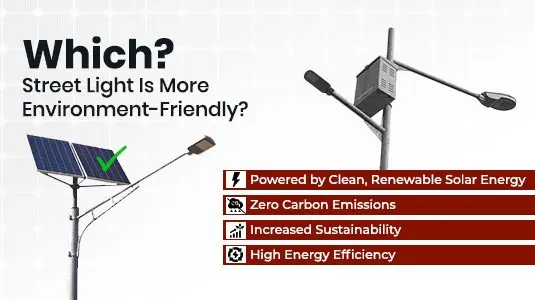Solar Street Lights vs. Traditional Street Lights: Which Is Better?
Street lights do more than just light up our roads. They make cities safer, help reduce accidents and make life after dark much easier. But as the energy prices rise and environmental concerns grow, many are turning to sustainable options. One such solution is the solar street light. It's not only powerful but also an eco-friendly option.
However, there are still some questions regarding solar street lights and traditional street lights. In this blog, we’ll understand which one provides better value and long-term benefits.
How Do Solar Street Lights Work?

Knowing how a solar street light works is the first step in making the right choice. Let's see what the working process is that sets the solar lighting system apart from traditional lights.
1. Solar Panels Absorb the Sunlight
You already know that without solar panels, no solar street light can function. These panels trap the sunlight to convert it into electricity. So this is why installing these panels in a place where sun rays fall in abundance is necessary.
2. Batteries Store the Energy
Now, the solar panels only generate electricity during the daytime. But there’s a need for solar street lights only during dark hours, so batteries become important. These act as a power bank and store energy for use during nighttime, ensuring there's no issue.
3. Automatic Lighting at Dusk
There are built-in light sensors for solar street lights. As the sun sets, these sensors detect low light and automatically turn on the solar street light and vice versa. This feature makes them really effective and convenient.
4. Batteries Power the LED Lights
The LED lights are operated by batteries that store energy. The lights are an excellent option due to their brightness and low power usage. Homes and streets are kept well-lit by these bright lights.
Cost Comparison: Solar vs. Traditional Street Lights
1. Initial Light Cost
- Solar: Prices range from ₹4,000 to ₹13,000 (depending on features and brand).
- Traditional: Typically between ₹900 and ₹8,999
2. Installation Cost
- Solar: ₹7,000 – ₹15,000.
- Traditional: ₹5,000 – ₹10,000.
3. Annual Electricity Cost
- Solar: ₹0 (powered by solar energy).
- Traditional: ₹2,000 – ₹5,000 (depends on local electricity rates).
Energy Efficiency of Solar Street Light
When it comes to energy efficiency, Solar street lights don't fail to impress. As these lights depend on the sun for power, there's no issue of power supply. The solar panels do their magic during the day and absorb the sunlight to convert it into electricity. So, during the nighttime, the same energy powers the LED lights.
LEDs have low energy consumption yet shine the brightest. They convert most of the energy into light. This is better than older street light technologies, which lose most of their energy.
The solar lighting system has one more amazing feature: a light sensor. These sensors are responsible for switching these lights on and off automatically. This increases their efficiency to a large degree.
Solar street lights also avoid the use of an electricity grid since they solely depend on the sun for power. This makes it excellent for regions where there is low grid connectivity.
Maintenance Requirements: Solar vs. Electric Street Lights
Maintenance is a major concern that arises when deciding between solar street lights and traditional streetlights. Individuals tend to opt for the system that needs less maintenance since it is cost-effective and saves time. With the rise of outdoor solar lighting, most individuals are changing their minds. Therefore, when it comes to street lights, what are the maintenance needs that make one superior to the other?
Let's see.
|
Aspect |
Solar Street Light |
Traditional Street Light |
|
Wiring Needs |
There is no wiring required as these lights are completely off-grid and independent. |
Traditional street lights need underground wiring and grid connection. These wires are prone to faults and damage. |
|
Bulb Lifespan |
Solar street lights come with LED bulbs that are long-lasting. These last typically 10-15 years. |
The use of bulbs like halogen or sodium vapour raises the need to change them every few years. |
|
Cleaning Requirements |
The solar panels require occasional cleaning to maintain their efficiency. |
The fixtures may require routine cleaning. |
|
Battery Maintenance |
The batteries usually last 8-10 years (depending on brand and type). However, these are easy to replace. |
There's no battery requirement as the power comes from the grid. |
|
Repair Complexity |
The solar street light only requires simple repairs. These repairs are usually limited to the unit. |
Traditional street light repairing is usually complex and may require rewiring. This is more time-consuming and expensive. |
|
Overall Maintenance Cost |
Low because of fewer replacements and no electricity bills. |
Higher because of regular inspections and repairs. The electricity bill is high too, based on consumption. |
Which Street Light Is More Environment-Friendly?

Are you still wondering which street light is more environmentally friendly? Well, the solar street light takes the spot because these street lights are better in all aspects.
Let's understand how.
1. Powered by Clean, Renewable Solar Energy
Solar street lights rely completely on solar energy, and you know that the sun is a renewable and green energy source. So what makes them wonderful and eco-friendly is that there's a constant use of sunlight. Solar street lights ditch fossil fuels and other non-renewable energy sources which are often harmful to the environment.
2. Zero Carbon Emissions
This is the greatest benefit of solar street lighting. These lights do not release carbon dioxide and other harmful greenhouse gases. The utilisation of sunlight makes these lights a green, clean source, offsetting climate change as well.
3. Increased Sustainability
Solar energy is sustainable and abundant. With the use of solar street lights in home or other areas, the use of oil, gas or coal is reduced. Traditional street lights, on the other hand, require constant consumption of non-renewable resources, making them unfit for the environment's health.
4. High Energy Efficiency
Solar street lights come with amazing features like motion and light sensors. These detect low light and motion and automatically turn on and off. This makes them great for use as these lights minimise energy wastage.
Also Read - Advantages and Disadvantages of Solar Street Light
Lifespan and Durability of Solar Street Lights
Solar street lights for home or other places are very efficient. However, knowing their durability and lifespan helps make better choices.
- Solar panels last 20-25 years. This makes solar street lights a good investment that is durable and sustainable.
- LED bulbs can operate efficiently for up to 15 years.
- Batteries need replacement every 5-7 years. It all depends on the type and capacity.
The secret to their great lifespan is the solar maintenance services along with their build. These street lights are made to ensure rough weather. Proper maintenance just adds to their durability!
Conclusion
After comparing solar street lights vs. traditional street lights, the answer is clear. Solar street lights are a better option when it comes to good value, energy saving and environmental benefits. The initial cost may be high, but the long-term financial benefits are worth looking into!
You can install solar street lights for home or business. Going solar never goes wrong!
With a good solar company like KLK Ventures, you can take a step ahead into a sustainable and bright future.
FAQs
- What is the best type of street light?
The best type of street light is a solar street light. It uses the sun’s energy and is completely eco-friendly.
2. Which street lights are best?
LED solar street lights are best as they are bright, energy-saving and also offer low-cost operation.
3. Why are LED street lights better?
LEDs last longer and use less energy. When paired with solar power, they become highly efficient.
